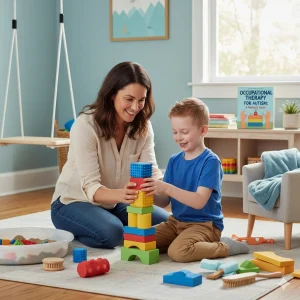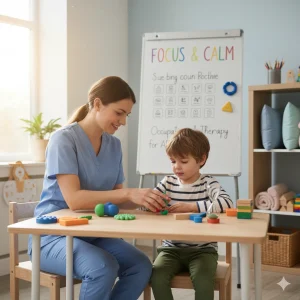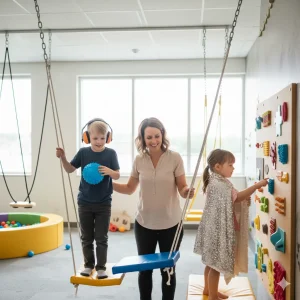Is My 3-Year-Old Just Shy, or Is It a Delay in Communication?
Last Updated: August 11, 2025
Is your 3-year-old’s speech development on track, or could it be a sign of a speech delay in toddlers? As parents, it’s natural to worry when our little ones don’t speak as clearly or confidently as their peers. But how do you differentiate between a shy toddler and one who may be experiencing a communication delay? In this article, we’ll explore the signs of speech delay in toddlers, discuss whether shyness might be affecting their communication, and help you understand when it’s time to seek professional advice. Whether you’re concerned about a delayed speech in toddlers or wondering if your child is just going through a shy phase, understanding the difference can make a world of difference in their early development.
Free Speech Help for Kids
Concerned about speech delays? Book a free consultation with our expert speech therapist and get guidance tailored to your child’s needs.
What is a Communication Delay in Toddlers?
Understanding Communication Delays in 3-Year-Olds
Communication is one of the most crucial skills a child develops in their early years. However, some toddlers may experience challenges in reaching their speech and language milestones. Communication delay in toddlers refers to a situation where a child has difficulty understanding or using language at the expected age level. This can include problems with speaking, understanding words, forming sentences, or even expressing themselves effectively.
Delayed speech in toddlers is a common concern that many parents face. While every child develops at their own pace, speech and language milestones are generally predictable. By age three, children are expected to use simple sentences, pronounce words clearly, and engage in basic conversations. When a child is not meeting these developmental benchmarks, it may indicate a delay in communication.
What Causes Communication Delays?
Communication delays can arise from a variety of factors. Some of the most common causes include:
- Genetics and Family History
- A family history of speech or language delays can increase the likelihood of a toddler facing similar challenges. If a parent or sibling had speech delays, the child may be more susceptible to developing a communication delay as well.
- Hearing Issues
- Hearing problems can significantly impact a child’s ability to develop language. If a toddler has frequent ear infections or a more serious hearing impairment, it may interfere with their ability to pick up sounds, words, and language patterns.
- Autism Spectrum Disorder (ASD)
- One of the early signs of autism is communication difficulties. Children with ASD often struggle with verbal communication, social interaction, and understanding nonverbal cues. If a child is showing signs of social communication challenges along with a delay in speech, it’s important to consult a pediatrician or speech therapist.
- Speech and Language Disorders
- Some children may have specific speech or language disorders, such as expressive language disorder (difficulty expressing thoughts or using words correctly) or receptive language disorder (difficulty understanding language). These disorders can contribute to delayed speech and hinder a toddler’s ability to communicate effectively.
- Environmental Factors
- A lack of exposure to language-rich environments, such as insufficient verbal interaction with caregivers or limited social engagement, can delay speech development. Children who are not encouraged to speak, read, or engage in conversation may show signs of speech delay.
- Cognitive Delays
- In some cases, a child may experience cognitive delays, which can also affect their communication abilities. A developmental delay may impact a toddler’s overall ability to process language, understand vocabulary, or use language for expression.
Signs of Communication Delay
Every child’s speech development is unique, and some may be slower than others in reaching certain milestones. However, delayed speech in toddlers is typically marked by specific signs, such as:
- Limited vocabulary for their age (e.g., fewer than 50 words by age 3).
- Difficulty putting together two- to three-word phrases.
- Trouble pronouncing common words clearly.
- Limited engagement in social conversations or play.
It’s essential for parents and caregivers to keep track of their child’s speech milestones and consult a pediatrician if they suspect a communication delay. Early detection and intervention can significantly improve a toddler’s chances of overcoming speech and language challenges.
Signs of Speech Delay in 3-Year-Olds
How to Recognize Speech Delay in Your Toddler
As parents, it’s natural to keep a close eye on your child’s development, especially when it comes to their speech and language milestones. By the time your child reaches age three, you might expect them to be using simple sentences, engaging in basic conversations, and pronouncing words with growing clarity. However, delayed speech in toddlers can often go unnoticed at first, especially if the signs are subtle. If you’re worried that your 3-year-old is not talking clearly, it’s important to be aware of the key signs that could indicate a speech delay.
| Signs of Speech Delay | Description |
|---|---|
| Limited Vocabulary for Age | By age three, children typically have a vocabulary of 200-1,000 words. A toddler with fewer words may have a delay. |
| Difficulty Forming Sentences | A 3-year-old should be combining words into simple sentences. If they’re still using single words or short phrases, it may indicate a delay. |
| Trouble Pronouncing Words Clearly | Difficulty in pronouncing common words (e.g., “wawa” for water) can be a sign of speech delay. |
| Lack of Social Interaction in Conversations | A child should engage in basic conversations by age three. If your toddler doesn’t show interest in conversing, it may indicate a delay. |
| Limited Understanding of Language | By age three, children should understand simple instructions. If your child struggles to follow directions, it could point to a communication delay. |
| Lack of Interest in Reading and Speaking Activities | A child’s disinterest in books or rhymes may suggest a delay. Reading and verbal play help in language development. |
Shyness vs. Speech Delay
Is It Shyness or a Speech Delay?
As parents, it’s common to worry when our toddlers show reluctance in speaking, especially in social situations. But how do you know whether your child is simply shy, or if there might be an underlying speech delay? The difference can sometimes be subtle, and it’s essential to understand the signs so you can support your child’s development in the best way possible.
What is Shyness?
Shyness is a natural temperament in many children, especially during early childhood. It’s common for a toddler to be cautious or reserved around new people or in unfamiliar situations. A shy child may prefer to observe rather than actively participate in social activities or conversations. However, over time, many shy children will gradually warm up to social interactions and begin to speak more freely as they become more comfortable.
Shy children often:
- Display hesitation when meeting new people or going to new places.
- May not speak much around strangers but are talkative with family members.
- Show a preference for observing rather than engaging in group activities.
- Often smile or nod but may avoid initiating conversations.
Shyness is generally not a cause for concern, and it typically resolves with time, especially in a supportive environment that encourages social interaction at their own pace. However, it’s important to differentiate between shyness vs speech delay to understand when additional support may be needed.
What is a Speech Delay?
A speech delay refers to a situation where a child’s language development is significantly slower than their peers. While shy children are still learning language and may just be reluctant to speak in social settings, a child with a speech delay may struggle to form sentences, understand language, or use words appropriately. A speech delay is often identified by a lack of vocabulary or difficulty in verbal communication that prevents a child from interacting with others effectively.
Children with a speech delay may exhibit signs such as:
- Limited vocabulary for their age.
- Difficulty combining words into sentences (e.g., saying “want cookie” instead of “I want a cookie”).
- Struggling to pronounce common words clearly (e.g., saying “wawa” for “water”).
- Limited social interaction and difficulty making basic requests or expressing themselves.
- Lack of interest in communication, even with close family members.
If your child seems unable to express themselves clearly or has trouble understanding what others are saying, this could indicate a speech delay rather than simple shyness.
How to Differentiate Shyness from Speech Delay?
While both shyness and speech delays can involve a reluctance to speak, the key difference lies in the child’s overall communication abilities and the context in which they avoid speaking. Here are some critical factors to consider when distinguishing between shyness vs speech delay:
- Social Behavior:
- A shy child may speak clearly to their family but avoid speaking to strangers.
- A child with a speech delay might avoid talking altogether, even with familiar people, due to difficulty expressing themselves.
- Non-Verbal Communication:
- Shy children often use gestures, eye contact, and body language to communicate. They can understand and follow simple directions.
- Children with speech delays may struggle with non-verbal communication as well, and may not use gestures as effectively to express themselves.
- Developmental Milestones:
- Shy children usually hit the same language milestones as their peers but may take a little longer to start speaking in social settings.
- Children with speech delays may miss important language milestones, such as using two-word phrases by age two or understanding basic instructions by age three.
- Response to Encouragement:
- Shy children will often start to speak more as they become more comfortable with their environment and the people around them.
- Children with speech delays may show frustration or struggle with expressing themselves, even when encouraged, as their challenges are not related to social hesitation but to language development.
When to Be Concerned About Speech Development
When to Seek Help for a Communication Delay
As a parent, it’s natural to feel a little concerned when your child’s speech development seems to be behind their peers. While some children naturally develop at their own pace, it’s important to know when a speech delay could be more than just a phase and when to take action. Early identification and intervention can make a significant difference in helping your child catch up and develop the communication skills they need for social and academic success.
A speech delay is a condition where a child’s ability to understand or produce language is not developing at the typical rate for their age. If you notice certain speech delay signs in children, it might be time to seek help from a professional to ensure your child gets the support they need to thrive.
When Should You Be Concerned About Speech Development?
While all children develop at different rates, there are specific milestones in speech and language development that are commonly expected at certain ages. If your child is missing these milestones, it could be an indication of a speech delay that requires professional attention. Here are the key signs that should raise concerns:
1. Limited Vocabulary for Their Age
By age 2, most children should have a vocabulary of at least 50 words. By age 3, that number should increase to around 200-1,000 words. If your child has significantly fewer words, or if they are unable to name common objects or people, this may be one of the speech delay signs in children.
If your toddler is not using words to express their needs or is relying heavily on gestures, this could point to a language delay that requires intervention. A lack of vocabulary can make it difficult for children to communicate effectively, which can affect their social interactions and academic progress later on.
2. Difficulty Forming Sentences
By the time a child turns three, they should be able to combine two or more words into simple sentences like “want cookie” or “big truck.” If your child is still only using single words or struggling to form even basic sentences, this could indicate a delay in their language development.
Children with a speech delay may have trouble stringing words together, making it challenging for them to express their thoughts and needs clearly. If they’re not using simple sentences by age 3 or 4, it’s worth discussing this with a speech-language pathologist (SLP).
3. Unclear Pronunciation or Frequent Speech Errors
At age three, most children should be able to pronounce many words clearly, even if they still make some minor errors. If your child’s speech is consistently unclear, making it difficult for others to understand them, this could be a red flag. For example, a 3-year-old not talking clearly might say “wawa” instead of “water” or “ba” instead of “ball,” which could indicate a speech delay that needs addressing.
If these speech errors persist and affect their ability to communicate effectively, it’s important to seek help from a professional to evaluate whether there’s a deeper issue at play, such as an articulation disorder or a language delay.
4. Trouble Understanding Simple Instructions
A child’s understanding of language develops alongside their ability to speak. By age three, most children should be able to follow simple directions like “please put the book on the shelf” or “give me the ball.” If your child seems to have difficulty understanding even basic requests, this could indicate a communication delay.
Children with speech delays may struggle with comprehension as well as expression, which can affect their overall communication skills. If your child appears confused or unable to respond appropriately to simple instructions, it’s time to seek professional advice.
5. Limited Social Interaction and Communication
Children with speech delays often have difficulty with social communication. By age 3, children should be engaging in basic conversations with family members and peers, even if their sentences are simple. If your child shows little interest in communicating with others, avoids eye contact, or seems unable to engage in back-and-forth interactions, this could be a sign of a speech delay.
Social communication skills are important for emotional development, and if your child is not showing interest in conversations or play, it’s essential to seek professional help to address any underlying issues.
6. Not Using Gestures or Non-Verbal Communication
By age one, most children start using gestures, such as waving “bye-bye” or pointing to things they want. If your child is not using gestures or facial expressions to communicate by the time they reach age two, it could be a sign of a communication delay. Children with speech delays may also show difficulty with non-verbal communication, making it harder for them to express their needs and emotions.
A lack of gestures and non-verbal cues can also affect a child’s social interactions, and it may be a good idea to consult a speech-language pathologist if this is a concern.
Early Intervention and Speech Therapy
How Early Intervention Can Help
When it comes to addressing speech delays in young children, early intervention is one of the most powerful tools available. Language is the foundation of a child’s ability to communicate, learn, and connect with others. When a child experiences a speech delay, the sooner intervention begins, the better the chances for overcoming the delay and ensuring they reach their full communication potential.
In this article, we’ll explore the importance of early intervention for speech delays and how speech therapy can dramatically improve a child’s language skills, boost their confidence, and set them up for future academic and social success.
What Is Early Intervention for Speech Delays?
Early intervention for speech delays refers to the identification and treatment of speech or language issues at the earliest possible stage. This often involves working with a speech-language pathologist (SLP) to assess the child’s needs and create a personalized treatment plan. The goal is to address any issues with understanding or producing language, so the child doesn’t fall behind in communication and other developmental areas.
Speech delays can manifest in many ways, including difficulty pronouncing words, limited vocabulary, problems with sentence formation, or challenges in understanding language. Early intervention focuses on helping children develop these skills in a structured, supportive environment.
Why Is Early Intervention So Important?
The first few years of life are crucial for brain development, and the earlier an issue is identified, the more effectively it can be addressed. Children’s brains are incredibly adaptable during these years, which means that early treatment for speech delays can lead to better long-term outcomes. Here’s why early intervention for speech delays is so important:
1. Enhances Language Development
Speech therapy helps children develop essential language skills by focusing on their ability to understand and express language. Early intervention targets specific issues, such as vocabulary building, sentence formation, and proper pronunciation, ensuring that the child doesn’t fall behind their peers in these fundamental skills. Speech therapy sessions may also involve teaching children how to use non-verbal communication, like gestures or facial expressions, to enhance their social interactions.
2. Boosts Confidence and Social Skills
Children with speech delays often experience frustration when they can’t express their thoughts or needs clearly. This can lead to feelings of embarrassment or withdrawal, which may affect their social interactions. Early speech therapy provides children with the tools they need to communicate effectively, helping them feel more confident and reducing the frustration that comes with communication difficulties.
By addressing speech delays early, children can develop the confidence to engage in conversations, participate in group activities, and make friends, which are crucial for their emotional and social development.
3. Prevents Future Learning Challenges
Language skills are critical to academic success. A child who struggles with speech and language development may also face difficulties in areas like reading, writing, and comprehension as they get older. These academic challenges can lead to a cycle of frustration and low self-esteem, which can be hard to break.
Early intervention for speech delays helps lay a strong foundation for literacy and learning. When speech and language issues are addressed early on, children are more likely to develop the skills necessary to succeed academically in later years.
4. Tailored Therapy to Meet Individual Needs
Each child is unique, and their specific challenges with speech and language will vary. One of the main benefits of early intervention is the ability to customize therapy to address the child’s individual needs. Speech-language pathologists (SLPs) work closely with parents to design a therapy plan that targets the areas where the child needs the most help, whether that’s pronunciation, vocabulary, or understanding complex instructions.
Personalized therapy ensures that children receive the right kind of support in the areas they need it most, which can accelerate their progress and improve the effectiveness of the intervention.
5. Strengthens Parent-Child Communication
Early intervention not only focuses on the child’s development but also educates parents on how to support their child’s speech and language progress at home. Speech therapists teach parents specific techniques and strategies to encourage communication skills, such as reading with their child, practicing speech exercises, and creating language-rich environments.
By learning how to actively participate in their child’s speech development, parents can reinforce therapy goals and create an environment that fosters communication growth in daily life.
How Does Speech Therapy Help?
Speech therapy involves various activities and techniques designed to address specific speech and language challenges. Some of the key components of early intervention for speech delays include:
- Articulation Therapy: Focuses on helping children pronounce words correctly, using techniques like repetition and visual cues.
- Language Therapy: Helps children expand their vocabulary, form sentences, and understand grammar rules.
- Social Communication Skills: Teaches children how to use language effectively in social situations, like starting and maintaining conversations or understanding non-verbal cues.
- Auditory Processing: Focuses on improving a child’s ability to understand and process spoken language, which is critical for effective communication.
When Should You Seek Early Intervention?
The earlier you can detect speech delays and start intervention, the better the outcome for your child. If you notice that your child is:
- Not meeting typical language milestones (e.g., not using two- or three-word phrases by age 2).
- Struggling to be understood by family members or peers.
- Having difficulty following simple directions or understanding language.
- Avoiding social interactions because of communication challenges.
It’s important to seek help from a professional. A pediatrician or speech-language pathologist can assess your child’s speech development and determine if early intervention for speech delays is necessary.
Conclusion
Understanding the difference between shyness vs speech delay is crucial for your child’s development. Shyness is temporary and usually doesn’t affect language milestones, while a communication delay in toddlers can prevent a child from meeting key speech milestones. Shy children might take time to warm up but still communicate effectively. However, a speech delay can lead to frustration and social withdrawal. If you’re concerned about your child’s speech development, seeking professional advice early is essential. Early intervention through speech therapy can help your child communicate confidently and catch up with peers.
Frequently Asked Questions:
1. What are the signs of speech delay in toddlers?
A speech delay in toddlers can be shown by a limited vocabulary, difficulty forming sentences, and unclear pronunciation. If your child is struggling to understand or follow simple instructions, it could be a sign of a communication delay in toddlers.
2. How do I know if my child is shy or has a speech delay?
Shyness in toddlers is temporary and often resolves over time. If your child is avoiding speaking or struggling to communicate even with family members, it may indicate a speech delay rather than just shyness. Look for signs like trouble forming sentences or limited vocabulary for their age.
3. When should I worry about my child’s speech development?
If your child is not meeting typical speech milestones, such as not using two- or three-word phrases by age 2 or not understanding simple instructions by age 3, it’s time to seek professional help. Early intervention for speech delays can make a big difference.
4. Is it normal for my 3-year-old to not talk clearly?
It’s normal for some 3-year-olds to have difficulty pronouncing words, but if your child’s speech is unclear and hard to understand consistently, it could be a speech delay. Early intervention with a speech therapist can help improve pronunciation.
5. Can a speech delay be caused by hearing problems?
Yes, hearing problems can affect speech development. If a child has frequent ear infections or other hearing issues, it may interfere with their ability to hear and learn language. If you suspect hearing problems, consult a pediatrician or speech-language pathologist.
6. How can I help my 3-year-old with a speech delay?
Encourage your child to speak by reading together, asking open-ended questions, and using simple language. It’s also helpful to provide opportunities for social interaction and play. If your child’s speech is significantly delayed, seeking early intervention for speech delays through speech therapy can be very beneficial.
7. What causes speech delays in toddlers?
Speech delays can be caused by various factors including genetics, hearing problems, speech disorders, cognitive delays, or a lack of exposure to language-rich environments. If you’re concerned, it’s important to get a professional evaluation.
8. How can I tell if my child has a communication delay or is just shy?
Shyness typically doesn’t affect language development. A shy child may still meet speech milestones but take longer to speak in social situations. A communication delay in toddlers, however, can involve trouble forming sentences, limited vocabulary, and difficulty following directions.
9. When should I consult a speech therapist for my child?
If you notice your child isn’t meeting expected speech milestones (like not speaking in full sentences by age 3), is hard to understand, or avoids communication, it may be time to see a speech-language pathologist. Early evaluation can help identify if there’s a speech delay that requires intervention.
10. Can speech therapy help with a communication delay?
Yes! Speech therapy can help children with a communication delay in toddlers by improving vocabulary, pronunciation, sentence structure, and social communication skills. Early therapy is especially effective in helping children catch up with their peers.
About the Author:
Anuradha Karanam
Speech-language pathologist (7+ years of experience)
Anuradha Karanam is a skilled speech-language pathologist with over 6 years of experience. Fluent in Tamil, Telugu, Hindi, and English, she specializes in parent counseling, speech sound disorders, fluency assessment, and speech-language evaluations. Anuradha excels at working with children with developmental disorders, offering creative and effective therapy programs. Currently, at Wellness Hub, she holds a BASLP degree and is registered with the RCI (CRR No A85500). Her patience, ambition, and dedication make her a trusted expert in her field.
Book your Free Consultation Today
Parent/Caregiver Info:
Client’s Details:
* Error Message









